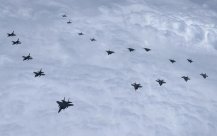
The pioneer hypersonic missile deployed by Russia can fly at a speed of 27 times the speed of sound and can be launched with intercontinental ballistic missiles. Because it can move rapidly after being separated from the power device, it is difficult to intercept.
Cai Tiancheng sorting
(Moscow Composite Electric) The Russian military was exposed on Friday and has begun to deploy the first pioneer hypersonic missile.The biggest feature of this type of missile is that it can fly at a speed of 27 times the speed, which can easily break through the US missile defense system, and tolerate the high temperature of 2,000 degrees Celsius.This advanced weapon may open a new chapter for the military reserve competition of the global nuclear military power.
The United States responded to this.U.S. officials said lightly on the same day that they did not doubt that Russia had a hypersonic missile that could carry nuclear warheads and could fly at a speed of more than 6080 kilometers per hour.If the Avangard hypersonic missile does play its function, it will inevitably improve Russia's nuclear force.
In March last year, Russian President Putin said in March that the Pioneer missile has begun to mass production and will be deployed this month as planned.Putin just threatened this Tuesday (24th) that the power of pioneers is enough to penetrate any existing and future missile defense systems.
Moscow invested many years and a lot of funds during the Cold War, trying to keep up with the United States in nuclear weapons technology and reverse the backward situation.
Russian Defense Minister Shaygan reported to Putin on Friday that the first pioneer hypersonic missile forces had been put into service.Karakayev, commander of the Russian strategic missile forces, notified that the unit has deployed a military unit in Orenburg near the Kazakhstan border.
The pioneer is launched with intercontinental ballistic missiles. Unlike the general conventional missile warhead, it is difficult to intercept the movement after being separated from the power device. It is very difficult to intercept.
Russia used it to put pressure on the United States to extend the Treaty of Military Reserve Competition between the two countries
The New York Times quoted to work and former diplomats that Russia actually hopes to put pressure on the United States, hoping to restart diplomatic negotiations, and extend the New Start of a strategic weapon (New Start) that will expire in 2021.According to the agreement between the United States and Russia, the treaty can be extended for five years after the expiration of February 2021.This treaty stops these two major military powers to launch unrestricted arms competitions.
The Trump administration just withdrew from the medium -range missile treaty signed in 1987 this year in August this year. This treaty aims to stop the development of medium -range missiles.The United States has no intention of extending a new treaty of strategic weapons. Trump has repeatedly reiterated that he will agree to extend the extension only by including China and other nuclear military powers.He even publicly screamed to start a new army competition, saying that American technology will win the final victory.
Putin publicly criticized the United States last week without Moscow's proposal to reduce the extension of the new treaty of strategic weapons.Putin said that once the treaty is invalidated, nothing worldwide can curb military reserve competitions, which will be a bad thing.
It is known that U.S. officials have suggested setting an inductive net in space to detect enemy missiles faster, especially hypersonic missiles.The Trump administration is also studying to intercept the feasibility of missiles in space and strive to shot it down within one minute of the enemy missile.
The New York Times pointed out that the United States is not a leading position in the research and development of hypersonic missiles.The U.S. Air Force is accelerating the test of two high -speed missiles, but these weapons will not be put into service until 2022.Although many departments under the US Department of Defense have their own hypersonic research projects, these can be seen after many years.
Nevertheless, military experts believe that the Russian hypersonic missiles have limited threats to the United States.Director -General of the US Weapon Control Association Kim Bar said that Russia's currently deployed hypersonic missiles are relatively small and will not exceed 24, so it will not significantly expand their threat to the United States.
However, he believes that, given the power of hypersonic missiles, the future US -Russian and Russian reduction of strategic weapons negotiations must be included in such weapons.Washington and Moscow should hold talks immediately to discuss how to control new weapons technology and various types of nuclear weapons to prevent either the fact that they can gain profit by speeding up the arms competition.




